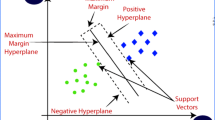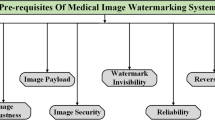Abstract
Digital medical images and image sequences, such as magnetic resonance imaging, computed tomography, and ultrasound, are widely used to diagnose diseases and abnormalities. The secure storage and exchange of such images and image sequences present challenges for hospital management. The objective of this study is to provide a framework for the integrity verification and copyright protection of medical images and image sequences. We design a systematic dual-medium watermarking model that focuses on the security of these images and sequences. Watermark bits (Wbs) are embedded in the transformed and temporal domains of images and image sequences, respectively, instead of in the spatial domain. The images are transformed using integer wavelet transforms, and motion vectors (MVs) are estimated from the image sequences to transform them into the temporal domain using seven block-matching algorithms. The best-performing MVs during frame reconstruction are reconstructed using a genetic algorithm to improve imperceptibility in the watermark-embedded image sequences. To increase the embedding capacity, the Wbs are embedded in regions with minimum or no movement, contrary to the conventional method. Conventionally, Wbs are embedded in regions of image sequences with significant movements. We evaluate the proposed model on typically used MATLAB test images and video datasets available online in Luminance (Y), blue–luminance (U), red–luminance (V) format. A comparison with five state-of-the-art methods shows that the proposed model outperforms the other methods in terms of imperceptibility and embedding capacity.








Similar content being viewed by others
Data Availability
Publically available.
Code Availability
Available Own developed code and algorithms.
References
Shih, F.Y.; Zhong, X.; Chang, I.-C.; Satoh, S.I.: An adjustable-purpose image watermarking technique by particle swarm optimization. Multimed. Tools Appl 77(2), 1623–1642 (2018)
Qasim, A.F.; Meziane, F.; Aspin, R.: Digital watermarking: applicability for developing trust in medical imaging workflows state of the art review. Comput. Sci. Rev. 27, 45–60 (2018)
Begum, M.; Uddin, M.S.: Digital image watermarking techniques: a review. Information 11(2), 110 (2020)
Pizzolante, R., Carpentieri, B., & Castiglione, A.: A secure low complexity approach for compression and transmission of 3-D medical images, IEEE. In: Eighth International Conference on Broadband and Wireless Computing, Communication and Applications, October 2013, pp. 387–392
Chitra, K., and Venkatesan, V.P.: Spatial domain watermarking technique: An introspective study. In: ICIA-16: Proceedings of the International Conference on Informatics and Analytics, August 2016 Article No.: 50, Pages 1–6. https://doi.org/10.1145/2980258.2980363
Muyco, S.D., and Hernandez, A.A.: Least significant bit hash algorithm for digital image watermarking authentication, ICCAI '19: Proceedings of the 2019 5th International Conference on Computing and Artificial Intelligence, April 2019, Pages 150–154 https://doi.org/10.1145/3330482.3330523
Zeki, A.; Abubakar, A.; Chiroma, H.: An intermediate significant bit (ISB) watermarking technique using neural networks. Springerplus 5(1), 868 (2016)
Moosazadeh, M.; Ekbatanifard, G.: A new DCT-based robust image watermarking method using teaching-learning-based optimization. J. Inf. Secur. Appl. 47, 28–38 (2019)
Sharma, S., Sharma, H., and Sharma, J.B.: ‘An adaptive color image watermarking using RDWT-SVD and artificial bee colony based quality metric strength factor optimization’, Applied Soft Computing, 2019, 84, pp. 105696
Thanki, R.; Borra, S.; Dwivedi, V.; Borisagar, K.: An efficient medical image watermarking scheme based on FDCuT–DCT. Eng. Sci. Technol. Int. J. 20(4), 1366–1379 (2017)
Ullah, R.; Alquhayz, H.A.: Intelligent watermarking scheme for image authentication and recovery. Int. J. Adv. Comput. Sci. Appl 8, 216–223 (2017)
Xuan, G., Yang, C., Zhen, Y., Shi, Y.Q., and Ni, Z.: Reversible data hiding using integer wavelet transform and companding technique, International Workshop on Digital Watermarking, IWDW 2004: Digital Watermarking pp 115–124 (Springer, 2004), pp. 115–124
Soleimanpour-Moghadam, M.; Talebi, S.: A novel technique for steganography method based on improved genetic algorithm optimization in spatial domain. Iranian J. Electr. Electron. Eng 9(2), 67–75 (2013)
Cedillo-Hernandez, A.; Cedillo-Hernandez, M.; Garcia-Vazquez, M.; Nakano-Miyatake, M.; Perez-Meana, H.; Ramirez-Acosta, A.: Transcoding resilient video watermarking scheme based on spatio-temporal HVS and DCT. Signal Process. 97, 40–54 (2014)
Gaobo, Y., Xingming, S., and Xiaojing, W.: A genetic algorithm based video watermarking in the DWT domain. In: 2006 International Conference on Computational Intelligence and Security, Guangzhou, China (IEEE, 2006), pp. 1209–1212
Himeur, Y.; Boukabou, A.: A robust and secure key-frames based video watermarking system using chaotic encryption. Multimed. Tools Appl. 77(7), 8603–8627 (2018)
Barjatya, A.: Block matching algorithms for motion estimation. IEEE Trans. Evol. Comput. 8(3), 225–239 (2004)
Li, R.; Zeng, B.; Liou, M.L.: A new three-step search algorithm for block motion estimation. IEEE Trans. Circuits Syst. Video Technol. 4(4), 438–442 (1994)
Lu, J.; Liou, M.L.: A simple and efficient search algorithm for block-matching motion estimation. IEEE Trans. Circuits Syst. Video Technol. 7(2), 429–433 (1997)
Po, L.-M.; Ma, W.-C.: A novel four-step search algorithm for fast block motion estimation. IEEE Trans. Circuits Syst. Video Technol. 6(3), 313–317 (1996)
Zhu, S.; Ma, K.-K.: A new diamond search algorithm for fast block-matching motion estimation. IEEE Trans. Image Process. 9(2), 287–290 (2000)
Nie, Y.; Ma, K.-K.: Adaptive rood pattern search for fast block-matching motion estimation. IEEE Trans. Image Process. 11(12), 1442–1449 (2002)
Jue, W., Min-qing, Z., and Juan-li, S.: Video steganography using motion vector components. In: 3rd International Conference on Communication Software and Networks (IEEE, 2011), pp. 500–503
Rezagholipour, K., and Eshghi, M.: Video steganography algorithm based on motion vector of moving object. In: Eighth International Conference on Information and Knowledge Technology (IKT) (IEEE, 2016), pp. 183–187
Abraham, J.; Paul, V.: An imperceptible spatial domain color image watermarking scheme. J. King Saud Univ.Comput. Inf. Sci. 31(1), 125–133 (2019)
Shaik, A., and Thanikaiselvan, V.: Comparative analysis of integer wavelet transforms in reversible data hiding using threshold based histogram modification. J. King Saud Univ. Comput. Inf. Sci., 2018
Hsu, L.-Y.; Hu, H.-T.: Robust blind image watermarking using crisscross inter-block prediction in the DCT domain. J. Vis. Commun. Image Represent. 46, 33–47 (2017)
Yao, Y.; Zhang, W.; Yu, N.; Zhao, X.: Defining embedding distortion for motion vector-based video steganography. Multimed. Tools Appl. 74(24), 11163–11186 (2015)
Rana, S.; Kamra, R.; Sur, A.: Motion vector based video steganography using homogeneous block selection. Multimed. Tools Appl. 79(9), 5881–5896 (2020)
Salman, S., A., Mustafa, S., S., and Gathban, S.A.: Block matching of motion estimation by using new technique quintet search algorithm. J. Eng. Appl. Sci. 15(6), 1346–1350 (2020)
Yaakob, R.; Aryanfar, A.; Halin, A.A.; Sulaiman, N.: A comparison of different block matching algorithms for motion estimation. Procedia Technol. 11, 199–205 (2013)
Hassanat, A., Almohammadi, K., Alkafaween, E., Abunawas, E., Hammouri, A., and Prasath, V.: Choosing mutation and crossover ratios for genetic algorithms—a review with a new dynamic approach. Information, 10, (12), pp. 390 (2019)
SIPI Image Database: http://sipi.usc.edu/database, accessed 10th July 2020
Test Images Collections: https://www.hlevkin.com/06testimages.htm, accessed 8th July 2020
YUV Test Sequences: http://vip.cs.nctu.edu.tw/resource_seq.html, accessed 25th June 2020
Amirtharajan, R.; Rayappan, J.B.B.: An intelligent chaotic embedding approach to enhance stego-image quality. Inf. Sci. 193, 115–124 (2012)
Kumar, V.; Kumar, D.: A modified DWT-based image steganography technique. Multimed. Tools Appl. 77(11), 13279–13308 (2018)
Bhuiyan, S.N.; Malek, N.A.; Khalifa, O.O.; Rahman, F.A.: An improved image steganography algorithm based on PVD. Indonesian J. Electr. Eng. Comput. Sci. 10(2), 569–577 (2018)
Wu, D.-C.; Tsai, W.-H.: A steganographic method for images by pixel-value differencing. Pattern Recogn. Lett. 24(9–10), 1613–1626 (2003)
Chang, K.-C., Chang, C.-P., Huang, P.S., and Tu, T.-M.: A novel image steganographic method using tri-way pixel-value differencing. J. Multimed. 3(2) (2008)
Aly, H.A.: Data hiding in motion vectors of compressed video based on their associated prediction error. IEEE Trans. Inf. Forensics Secur. 6(1), 14–18 (2010)
Xu, C., Ping, X., and Zhang, T.: ‘Steganography in compressed video stream. In: First International Conference on Innovative Computing, Information and Control (ICICIC 2006), 30 August–1 September, Beijing, China’ (IEEE, 2006), pp. 269–272
Cao, Y., Zhao, X., Feng, D., and Sheng, R.: ‘Video steganography with perturbed motion estimation’, In: Information Hiding—13th International Conference, IH 2011, Prague, Czech Republic, May 18–20, Revised Selected Papers (Springer, 2011), pp. 193–207
Funding
The authors would like to thank the Deanship of Scientific Research at Majmaah University for supporting this work under Project Number No. 1439–13.
Author information
Authors and Affiliations
Contributions
HA Initial idea, research design, first draft, results analyses, final review. BR, proposed model, implementation, experiments and results discussions, review and final draft.
Corresponding author
Ethics declarations
Conflict of interest
Authors declare no conflict of interest.
Rights and permissions
About this article
Cite this article
Alquhayz, H., Raza, B. Watermarking Techniques for the Security of Medical Images and Image Sequences. Arab J Sci Eng 47, 9471–9488 (2022). https://doi.org/10.1007/s13369-021-06254-7
Received:
Accepted:
Published:
Issue Date:
DOI: https://doi.org/10.1007/s13369-021-06254-7




